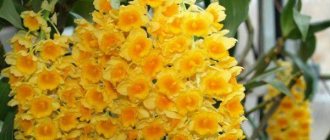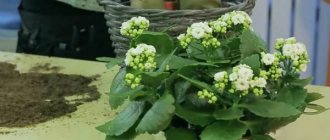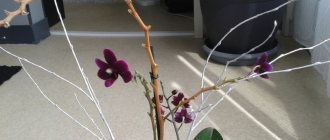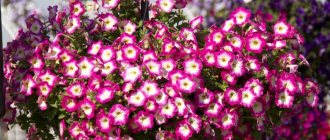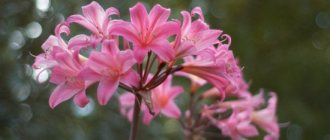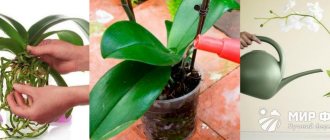The orchid is one of the oldest plants, represented by more than 40 thousand varieties, native to the tropical zones of our planet. Previously, this flower was considered a medicine, and therefore was treated with special awe and respect. This flower appeared in Europe about 200 years ago and immediately attracted the attention of flower growers. At the moment, the orchid is one of the most popular indoor “pets”, which can be found almost everywhere.
Florists do not deny that the reason for the demand for this crop is the chic, delicate buds that the plant produces during the flowering period. In order for a flower to please its owner for a long time with a juicy, healthy inflorescence and regularly produce new flowers, it is necessary to properly care for the orchid during the flowering period and after it. Read below about exactly how to do this.
What happens to a plant when it blooms?
Orchids can bloom at any time of the year . To do this, you just need to meet certain conditions. The duration of flowering can reach three months, although there are cases where orchids have been pleased with flowers for five or even eight months. The flowering process begins with the growth of a long peduncle that develops over two months. Then buds appear on it, which subsequently bloom.
Caring for a phalaenopsis orchid during flowering
- providing the required amount of light;
- maintaining a temperature comfortable for the plant;
- providing the flower with necessary minerals and trace elements;
- timely cessation of watering and fertilizing after flowering;
- adjusting the length of the peduncle;
- the beginning of a new cycle of preparation for flowering.
Reducing watering and fertilizers simultaneously with a decrease in air temperature is required in order not to exhaust the plant with an unnecessary growing season and to put it into a dormant state.
Differences in care during and after buds open
At each period of development, the orchid needs certain care.
When it just begins to gain strength for the development of the peduncle, special feeding is important to help the flower develop faster.- The process of watering during the flowering period and during the dormant period is characterized by abundance: as soon as the room becomes cool, the amount of water is reduced (you can find out how to properly organize care if the orchid has bloomed here).
- After flowering, the plant needs pruning. You can replant indoor crops only after the end of this period.
Possible problems
Flowering epiphytes react very sharply to any changes in care. Therefore, there is a high probability that problems may arise. One of the most common is the wilting of flowers. It is caused by cold air or moving the flower to another room.
If darkened areas appear on the petals, then the reason lies in the water that got on the buds. When irrigating, it is important to direct water only to the substrate, without affecting the leaves and flowers. Severe waterlogging of the soil provokes the development of brown rot. To solve this problem, all affected areas are cut off and treated with crushed coal. If the rot is gray in color, the cause is a fungal infection. To eliminate it, they are treated with fungicidal preparations. Pests are destroyed with a solution of Actellik or Fitoverm.
Pollination process
Using a toothpick or tweezers, the anther cap is separated from the stigma, from which pollinia are then isolated , which are two small yellow balls. At the bottom of the column of another flower, a small depression is found into which pollinia are inserted.
Attention : Do not touch the walls of the column with a toothpick or anything else, as this may damage the column. The stigmas should only touch the pollinia.
If pollination was successful, the column will close within a day. Both flowers used for pollination will wither. Within six to eight months, if the result is successful, a seed box will form.
We recommend watching a video about pollinating an orchid at home:
Difficulties in growing orchids at home
When growing an orchid, a number of difficulties may arise:
| Problem | Cause | Solution |
| There is no flowering, the plant dries out. | Lack of light, too large container for growing, sudden temperature changes. | If the plant is located on the north side of the house or the daylight hours are short, fluorescent lamps are used. At night the temperature should be +14…+16°C. |
| The foliage is turning yellow. | Waterlogging or low air humidity, placement in a draft, in a dark place. | Normalize the watering schedule and increase air humidity. The plant is placed in a bright place where there is no access to drafts. |
How to care for a flowering plant?
An orchid requires special attention during flowering , since improper care can shorten this process. Let's look at how to care for a flowering plant.
Moving the pot
During the flowering period, a pot with an orchid cannot be moved from place to place, since changing the location will become stressful for the indoor plant. The plant may begin to drop flowers, resulting in a shorter flowering period. It is necessary to choose the right place for the orchid from the very beginning.
Watering
Watering plays an important role as the plant requires strength to maintain flowers . The frequency of watering depends on the type of orchid. The soil in which phalaenopsis grows must be constantly moist, and the dendrobium substrate must dry completely before the next watering. During the flowering period, you should not overdo it with moisture. With a lack of moisture, the leaves and pseudobulbs will begin to wrinkle, and excessive moisture will cause yellowing of the leaves and rotting of the root system.
Water the orchid when the color of its roots changes from green to silver. This means they have dried out. For irrigation use soft, settled water. The approximate frequency of watering in summer ranges from one to three times a week. In winter, the frequency reaches once or twice every seven days. Watering is carried out by immersion or from above.
We recommend watching a video about proper watering of a blooming orchid:
Humidity
A blooming orchid feels comfortable under natural air humidity observed in room conditions. The appropriate rate ranges from 40 to 70 percent.
If the air in the apartment is drier, the plant will stop growing and the flowers will begin to fall off. This occurs during hot summers or winters under the influence of central heating batteries. Humidity is increased by placing a container of water or a tray with moistened expanded clay next to the flower. Some types of orchids can be sprayed, making sure that moisture does not penetrate into the axils of the leaves.
Lighting and temperature
An orchid needs good lighting, since a sufficient amount of light allows it to regularly produce flower stalks. If the lighting is weak, the leaves begin to lighten, stretch out and acquire a yellow color. The orchid requires diffused light , as well as protection from direct rays of the sun, which cause burns.
In the summer, a blooming orchid is shaded using curtains, film or plastic. The plant is provided with a long twelve-hour daylight hours. If an orchid blooms in winter, it will need additional lighting using fluorescent lamps.
The set temperature depends on the type of orchid being grown.:
Phalaenopsis, dendrobiums and some other groups love warmth because they naturally grow in areas with a tropical climate. In summer, the temperature for them is set from 15 to 32 degrees, and in winter – from 15 to 18 degrees.- The second type of orchids includes plants that naturally occur in the middle mountain zones of the tropics, for example, miltonias and odontoglossums. For them, in the summer, the temperature during the day is kept at a level of 18 to 22 degrees, and in winter at night, a range of 12 to 15 degrees is required.
- The third group of orchids grows in the subtropics, so they prefer cool conditions at home (Australian dendrobiums, laelia). In summer, the temperature should not rise above 22 degrees.
Top dressing
The orchid does not need frequent feeding, since it reduces the plant’s natural immunity and provokes the development of unpleasant diseases. During the flowering period, root fertilizers are completely abandoned, replacing them with foliar fertilizers. You can use special liquid fertilizers for orchids, but it is recommended to prepare the solution three times less concentrated than indicated in the instructions for the preparation.
We recommend watching a video about proper feeding of a blooming orchid:
Trimming
During flowering, the orchid, of course, is not pruned . The peduncle is disposed of when the process is complete. There is no need to rush with pruning, because the orchid can bloom again, releasing new flowers from the buds of the old arrow. Once all the flowers have withered, give the plant time to stand to make sure there are no new buds.
Tip : It is recommended to resort to pruning when the peduncle has completely dried out, since, being in a green state, it supplies the rest of the plant with nutrients. Using a sharp knife, cut the arrow at the very base, leaving a short stalk three centimeters long.
Transfer
It is not recommended to replant the plant during the flowering period . The exception is the situation when you purchased an already blooming orchid and discovered that it is in a substrate consisting only of sphagnum moss.
Carefully transfer it into a pot that is two centimeters larger in diameter, using a substrate suitable for the orchid, purchased in a store or prepared independently. If the production soil includes bark, there is no need to disturb the orchid and you should wait until after flowering to replant.
We recommend watching a video about how to properly transplant a blooming orchid:
Flowering period and duration
There is no clearly defined period when flowers appear on orchids. Too many factors influence this process. If you properly and systematically care for the epiphyte, you can achieve flowering twice a year. But in other years, the flowers may not bloom at all. When flowering ends, the orchid is given a period of rest to recuperate.
On average, the flowering period lasts 3 months. But sometimes it ends earlier. This may be due to the following factors:
- The plant can bloom for a long time in the store before purchasing. Then there is a high probability that after buying a house it will quickly shed its buds.
- The heat in the room and dry air do not contribute to long-term flowering.
- Watering too much is also harmful to plants. Due to the abundance of moisture, the root system suffers and the orchid drops its buds.
In favorable conditions and with careful care, you can extend the flowering of an orchid up to eight months. This process lasts especially long in epiphytes acquired in flowering form in winter. Then spring rays awaken dormant flower buds, which release new flower arrows. As a result, you can achieve an extension of the period with flowers.
How to prolong flowering, what to do if it doesn’t bloom?
Prolongs the flowering of the orchid with proper care . You cannot rearrange it, overfeed it or fill it up.
Proper care will allow the plant to bloom for as long as possible. It is not so difficult to shorten the flowering period: it is enough to disrupt the conditions necessary for the orchid, for example, put it in a dark place.
An orchid may not bloom because it feels too good and puts all its energy into developing green mass. They resort to shock therapy: the pot with the culture is transferred to a cool room and the watering is stopped. Extreme conditions will trigger the plant to begin flowering.
Is artificial stimulation allowed?
You should not artificially stimulate the color of a young orchid, because there is a high probability of the plant dying. However, there are several ways to help the flower bloom, provided the orchid is healthy and well cared for. Stimulation methods:
- Organize a temperature difference at night, sending the plant to the coolest place, and in the morning to a warm one. After a stressful situation, flower stalks often appear.
- Make changes to the irrigation system.
- Apply additional compounds, such as “Plumen”, “Bud”, “Ovary”.
Experienced gardeners use hot showers as a means of stimulating color. The process consists of rinsing the plant crop under running water at a temperature of 40-45C. 2-3 approaches of 10 seconds with breaks of 15-20 minutes almost always help to invigorate a spectacular exotic. Sensing danger, the plant seeks to leave offspring, throwing out flower stalks. This technique is dangerous and is used in extreme cases.

